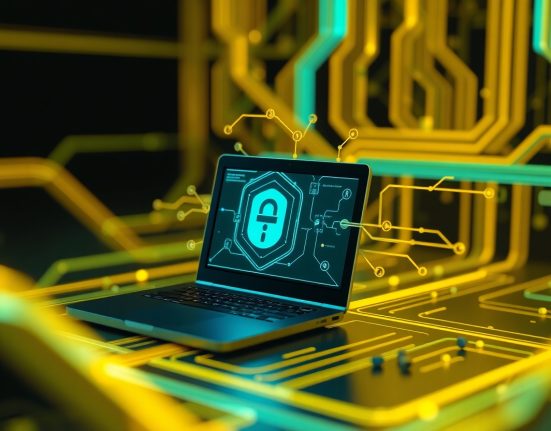In an age where data is the most valuable asset, securing it has become a top priority. Quantum encryption technologies, combined with artificial intelligence, offer innovative solutions for protecting personal and organizational information. Are these technologies marking the end of the password era? In this article, we will explore in depth the revolution taking place in the world of information security and digital identification.
What is Quantum Encryption?
Quantum encryption is based on principles of quantum mechanics that enable the creation of encryption keys which cannot be duplicated or intercepted without introducing detectable changes. This technology, also known as Quantum Key Distribution (QKD), represents a significant breakthrough in information security.
The scientific basis behind quantum encryption is founded on two central principles in quantum mechanics:
- Heisenberg’s Uncertainty Principle – It is impossible to simultaneously measure with precision both the position and momentum of a quantum particle.
- Quantum Collapse Phenomenon – Any attempt to measure a quantum state irreversibly changes it.
When information is encrypted using photons (light particles) in different quantum states, any attempt by a third party to intercept the information will cause a change in the quantum state of the photons, which will be immediately detected by the legitimate recipient. This advantage makes quantum encryption a method approaching perfect security from a theoretical perspective.
In practice, companies like Swiss ID Quantique and Toshiba Europe already operate commercial communication networks based on quantum encryption, primarily in the financial sector and government institutions. Despite the high cost and technical limitations (such as the need for dedicated physical infrastructure), the adoption rate of this technology is on an upward trend.
It’s important to emphasize that quantum encryption secures the transfer of information but does not eliminate the need to identify and authenticate users themselves. This is where advanced identification solutions come into play, as we will elaborate further.
The Threat of Quantum Computing
While quantum encryption offers unprecedented protection, quantum computing poses a threat to existing encryption methods. Future quantum computers are expected to have the capability to break today’s standard encryption algorithms used on the internet.
Shor’s Algorithm, developed in 1994, demonstrates how a quantum computer is capable of breaking RSA encryption – a common encryption method currently used to protect internet communications, banking transactions, and electronic commerce. While it would take a classical computer billions of years to crack a strong RSA key, a quantum computer could do so within hours or days.
This danger constitutes a global threat to information security, and many countries are investing significant resources in developing encryption systems resistant to quantum attacks, a field known as “Post-Quantum Cryptography.” The American National Institute of Standards and Technology (NIST) is conducting an international competition to develop quantum-resistant encryption algorithms and has already selected several promising algorithms that are now in standardization processes.
According to a McKinsey report, about 25% of large organizations worldwide are already in the process of implementing security solutions resistant to quantum computing. However, adopting these solutions requires significant planning and investment, as there is a need to replace all existing encryption systems in the organization.
Are Passwords on Their Way Out?
While quantum encryption strengthens communication security, passwords are still the most common method for verifying user identity. However, several technologies offer safer alternatives:
Biometric Authentication
Biometric identification technologies have developed significantly in recent years. Fingerprint recognition systems, retinal scanning, facial recognition, and voice recognition have become much more accurate and resistant to forgery. Research by Juniper Research indicates that by 2026, more than 70% of smartphones worldwide will use biometric identification as the primary security method.
The advantages of biometric identification include:
- Convenience – No need to remember complex passwords
- Speed – Identification is completed in fractions of a second
- Difficulty in forgery – Especially in systems combining multiple biometric identification methods
- Reduction in dependency on the “human factor” – Reducing the risk of human error
However, biometric identification also has disadvantages that slow its full adoption:
- Privacy issues – Biometric data is especially personal
- Difficulty in replacement – You cannot “change” a compromised fingerprint
- Imperfect accuracy – Cases of misidentification still exist, especially in diverse populations
Physical Security Keys
Physical security keys, such as YubiKey, Google Titan, and SoloKeys, have become popular among organizations and large technology companies. These are small devices that connect to a computer or smartphone and serve as a “second factor” in identity authentication.
Advantages of physical keys:
- High resistance to phishing attacks – Even if a user discloses their password, the attacker still needs the physical key
- Simplicity of use – A single touch or USB connection is sufficient
- No dependency on cellular network connection – Unlike authentication applications
Google data shows that since the company began using physical security keys for its employees, there has not been a single case of a successful phishing attack.
Multi-Factor Authentication (MFA)
Multi-factor authentication combines at least two of the following factors:
- Something you know – Password or PIN
- Something you have – Smartphone or physical security key
- Something you are – Biometric data
- Location – GPS coordinates or known network
- Behavior – Typing pattern, mouse movement, or other usage patterns
According to a Microsoft report, using multi-factor authentication prevents 99.9% of password-based attacks. However, only about 22% of private users consistently use these systems, compared to about 78% of business organizations.
Combining quantum encryption with these authentication methods can significantly reduce dependence on passwords in the future. For instance, ISARA Corporation is developing solutions that combine multi-factor authentication with encryption technologies resistant to quantum computing.
The Role of Artificial Intelligence
Artificial intelligence affects the world of information security in two opposing ways:
Enhancing Security Systems
AI systems can improve information security in several ways:
- Detecting unusual usage patterns – Machine learning systems can learn the user’s normal behavior patterns (login times, locations, frequency of actions) and alert on deviations. Darktrace reports a 97% detection capability of cyber attacks before they cause damage.
- Behavioral authentication – AI systems identify unique behavioral patterns such as typing style, mouse movements, or even how a phone is held. BioCatch reports an 80% reduction in identity fraud through this technology.
- Personalization of authentication protocols – AI can adjust the required security level according to the risk level of the action and user. For example, transferring large sums of money will require more stringent authentication than reading emails.
- Network anomaly analysis – AI systems monitor network traffic and identify abnormal communication patterns indicating malicious activity.
According to a Gartner report, by 2026, more than 60% of organizations will integrate AI into their information security systems.
Malicious Use of Artificial Intelligence
In parallel, artificial intelligence is also being used to develop more sophisticated attack tools:
- Advanced phishing attacks – AI systems can create personalized phishing messages tailored to the target, using information gathered from social networks and other open sources.
- Password recovery – AI algorithms can guess passwords much more efficiently than traditional “brute force” attacks, by analyzing patterns and connections in previous passwords.
- Creating DeepFakes – AI can forge voice, video, or images to bypass biometric identification systems. A 2023 study showed that 43% of facial recognition systems can be deceived using advanced DeepFakes.
- Adversarial Machine Learning attacks – Techniques that exploit weaknesses in machine learning systems to deceive them. For example, tiny changes invisible to the human eye in an image can cause a facial recognition system to identify a completely different person.
Challenges and Solutions in Combining Quantum Encryption and Artificial Intelligence
The combination of quantum encryption and artificial intelligence offers powerful defense potential but also raises new challenges:
Challenges
- Technological complexity – Implementing quantum encryption systems requires in-depth knowledge and dedicated infrastructure, making widespread adoption difficult.
- High costs – The investment required to implement quantum encryption solutions is still high, limiting accessibility mainly to large organizations and governments.
- Privacy issues – Using artificial intelligence to monitor user behavior raises concerns about privacy and ethics.
- Need for standardization – Lack of unified standards makes it difficult for the industry to adopt new solutions.
- Physical limitations – Quantum communication is currently limited to distances of hundreds of kilometers, although research in “quantum relays” is trying to overcome this limitation.
Developing Solutions
- Quantum cloud services – Companies like IBM, Google, and Amazon are developing cloud solutions that offer access to quantum encryption technologies without the need to invest in infrastructure.
- Hybrid approaches – Combining classical encryption with quantum elements, allowing for gradual implementation.
- Quantum-resistant networks – Implementing post-quantum encryption in existing networks to protect against future threats.
- Integrating AI in quantum encryption – Crypto Quantique is developing chips that combine quantum key generators with machine learning algorithms for attack detection.
Looking to the Future: Predictions and Trends
Information security experts offer several predictions regarding the future of passwords and digital authentication:
- Passwords as a secondary defense layer – By 2028, it is expected that passwords will become merely a secondary security layer, with other authentication means forming the primary layer.
- Continuous and unobtrusive identification – Instead of one-time authentication at system entry, systems are expected to continuously check the user’s identity based on behavior, location, and additional parameters.
- “Universal Digital Passport” – International efforts are advancing to create a secure digital identification system that will serve for a variety of services and applications.
- Adapting security level according to risk level – Smart authentication systems will adjust the required authentication level according to the requested action, the user, and the context.
- Context-aware security – Security systems will consider factors such as location, time, activity history, and device to determine user reliability.
Gartner estimates that by 2030, more than 80% of interactions with digital services will not include the use of a traditional password.
Conclusion
Quantum encryption and artificial intelligence are shaping a promising future in the field of information security. While passwords won’t disappear overnight, their role is expected to significantly diminish as more secure and intelligent identity verification methods become standard.
The main challenge in the coming years will be finding the right balance between advanced security and user convenience, while addressing issues of privacy and ethics. Organizations that succeed in finding this balance will gain a significant competitive advantage in the digital era.
Ultimately, the future is not necessarily in replacing passwords, but in creating an ecological security system that includes multiple complementary defense layers, adapted to the changing needs of users and organizations.














